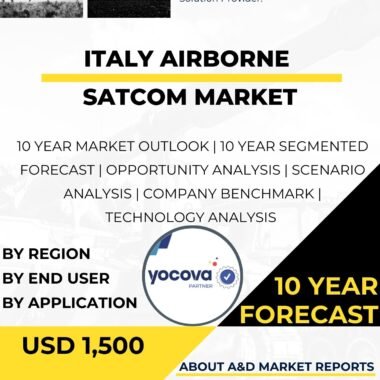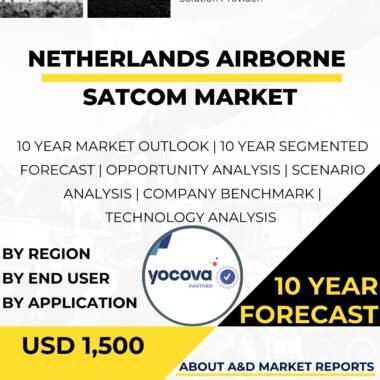Description
Sweden Airborne SATCOM Market
The Sweden Airborne SATCOM market has become a vital aspect of the country’s defense strategy and civil aviation industry, driven by the need for reliable and secure communication links for aircraft operating in remote and challenging environments. As a nation with advanced technological capabilities and a strong aerospace and defense sector, Sweden has actively invested in airborne SATCOM technology to enhance military communications, enable seamless data exchange in-flight, and support various civil aviation applications.
Airborne SATCOM systems provide essential communication links for aircraft, allowing them to exchange data, voice, and video with ground stations, other aircraft, and satellite networks. These systems are critical for military operations, air traffic management, and passenger connectivity, making them indispensable in modern aviation.
In the defense sector, the airborne SATCOM market in Sweden is of strategic significance, as it enables secure and uninterrupted communication for military aircraft operating in remote and hostile environments. Military missions often require real-time communication and data transfer between aircraft, ground stations, and command centers. Airborne SATCOM ensures reliable and encrypted communication, enhancing situational awareness, mission coordination, and operational effectiveness.
Sweden’s strong commitment to national security and defense modernization has driven its investment in indigenous airborne SATCOM technology. The country’s aerospace and defense industry has been at the forefront of developing advanced SATCOM systems for military aircraft, tailoring solutions to meet the specific needs of Sweden’s armed forces. This domestic expertise not only ensures self-sufficiency in communication technology but also contributes to the country’s position as a reliable supplier of airborne SATCOM systems in the global market.
The airborne SATCOM market in Sweden also plays a crucial role in civil aviation, particularly in the context of passenger connectivity and in-flight entertainment. As demand for in-flight internet access and entertainment options increases, airlines seek reliable and high-speed SATCOM systems to enhance the passenger experience. Airborne SATCOM enables passengers to access the internet, stream content, and stay connected during flights, making long-haul travel more enjoyable and productive.
Additionally, airborne SATCOM is essential for air traffic management, allowing real-time communication between air traffic controllers and aircraft. Sweden’s airspace, being vast and including remote regions, requires effective communication infrastructure to ensure safe and efficient air travel. Airborne SATCOM systems support seamless and reliable communication between aircraft and air traffic management centers, contributing to the safe and orderly flow of air traffic.
Sweden’s aerospace and defense industry has been instrumental in developing and integrating advanced airborne SATCOM systems into military and civilian aircraft. These systems leverage cutting-edge technologies to provide high data transfer rates, encryption capabilities, and seamless communication handovers between different satellite constellations. The country’s indigenous capabilities allow for customization and adaptation of airborne SATCOM solutions, ensuring compatibility with different aircraft platforms and operational requirements.
Furthermore, Sweden actively participates in international collaborations and partnerships to enhance its airborne SATCOM capabilities. Working with other European nations and global defense contractors fosters knowledge exchange, enhances interoperability, and ensures compatibility with allied forces during joint military operations and civil aviation endeavors.
The airborne SATCOM market in Sweden is not without its challenges, and one primary consideration is cost-effectiveness. Developing and deploying advanced SATCOM systems can be expensive, particularly as technology rapidly evolves. Sweden’s defense industry must focus on optimizing SATCOM solutions to ensure affordability without compromising on performance and security.
Moreover, ensuring the cybersecurity of airborne SATCOM systems is of utmost importance. As aircraft become more connected and reliant on SATCOM for critical functions, they become potential targets for cyberattacks. Sweden’s defense industry must remain vigilant in developing robust cybersecurity measures to protect airborne SATCOM systems from malicious threats and unauthorized access.
In conclusion, the Airborne SATCOM market in Sweden holds significant importance for the country’s defense capabilities and civil aviation industry. Airborne SATCOM technology provides essential communication links for military aircraft, supporting real-time data exchange, mission coordination, and situational awareness. Sweden’s commitment to technological advancement and self-sufficiency in defense technology has driven its investment in indigenous airborne SATCOM systems, ensuring reliability and security in military communications. Additionally, airborne SATCOM enhances civil aviation by providing in-flight connectivity for passengers, improving air traffic management, and supporting seamless data exchange during flights. By addressing cost-effectiveness and cybersecurity concerns and fostering international collaborations, Sweden is well-positioned to maintain a leading role in the airborne SATCOM market, contributing to enhanced defense capabilities, aviation efficiency, and passenger experience both domestically and on the global stage.




